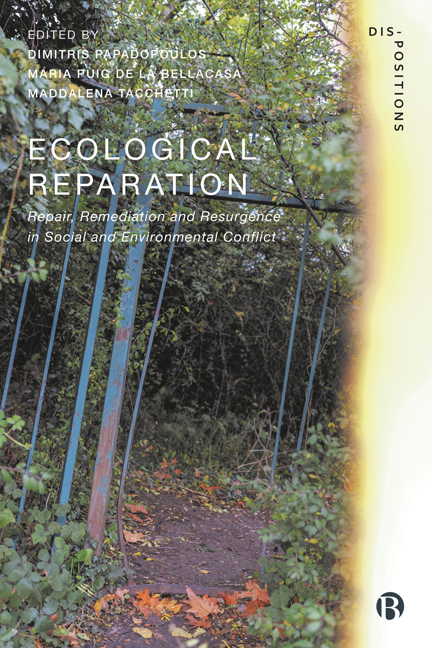Book contents
- Frontmatter
- Contents
- List of Figures
- Notes on Contributors
- Acknowledgements
- Note on the Figures
- Dis-Positions Series Preface
- Introduction: No Justice, No Ecological Peace: The Groundings of Ecological Reparation
- PART I Depletion<>Resurgence
- PART II Deskilling<>Experimenting
- PART III Contaminating<>Cohabiting
- PART IV Enclosing<>Reclaiming Land
- PART V Loss<>Recollecting
- PART VI Representing<>Self-governing
- PART VII Isolating<>Embodying
- PART VIII Growth<>Flourishing
- Index
8 - Involvement as an Ethics for More than Human Interdependencies
Published online by Cambridge University Press: 28 March 2024
- Frontmatter
- Contents
- List of Figures
- Notes on Contributors
- Acknowledgements
- Note on the Figures
- Dis-Positions Series Preface
- Introduction: No Justice, No Ecological Peace: The Groundings of Ecological Reparation
- PART I Depletion<>Resurgence
- PART II Deskilling<>Experimenting
- PART III Contaminating<>Cohabiting
- PART IV Enclosing<>Reclaiming Land
- PART V Loss<>Recollecting
- PART VI Representing<>Self-governing
- PART VII Isolating<>Embodying
- PART VIII Growth<>Flourishing
- Index
Summary
Restoring 200 sq km of kelp forest off the Sussex coast, creating new habitat for heat-sensitive butterflies and connecting fractured wetlands for the reintroduction of beavers – these are some of the 12 UK Wildlife Trusts schemes funded last month to recreate wetlands, restore peatlands and reintroduce beavers, all of which aim to help the UK tackle climate change. They are just some of the thousands of projects that are being deployed throughout the world to address the devastating effects of climate change, extinction, biodiversity reduction, systemic pollution, sea level rise and global warming. These interrelated processes are rapidly changing the physical and affective conditions of the planet, increasing inequality, mass migration and resource colonialism, among other social crises. Therefore, social and ecological relations require radical improvements. The protection, conservation and remediation of existing ecologies is at the forefront of the strategies to compensate for, delay or adapt to these challenges.
Projects like the ones funded by the UK Wildlife Trust are relevant contributions, and the diversity of approaches reflect the complexity of doing so. However, terms like restoration and repair are becoming exchangeable and often unquestionable buzzwords that give little information about the aims of the intervention or what exactly will be done. In addition, at least from my experience as an architecture studio design professor, concepts like repair and remediation seem to justify any intervention because they are ‘solutions’ to ‘global challenges’. They are approached as seamless and easy processes: ‘we put this here, change this there, these others will transform each other’ and ‘voila’. Repaired. Ecologies are repaired as if they were buildings, with the same techno-scientific mindset: trees substitute bricks and animals substitute mortar. But are concepts like reparation and restoration best suited to address the complex ecological reality we are living in?
Reparation (and repair, remediation, restoration …)
In common language, words like reparation, remediation and restoration have different meanings. Reparation speaks about making an entity function again, or stopping it being broken. Remediation comes from remedy, to cure a body (human or not). Meanwhile, restoration implies a transformation to achieve a similarity with the past: to make something look or function as it did before. The type of intervention also varies depending on the object of reparation, whether it is violence against Indigenous peoples, a pond, a house façade or a 13th-century painting.
- Type
- Chapter
- Information
- Ecological ReparationRepair, Remediation and Resurgence in Social and Environmental Conflict, pp. 137 - 152Publisher: Bristol University PressPrint publication year: 2023

